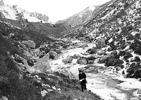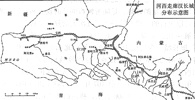Translated by CDT from People Online:
China’s glaciers have retreated 7.4% on average compared with the period between 1950s-1980s, according to a recent glacier resources survey led by former meteorological chief Qin Dahe, a Member of the Chinese Academy of Sciences. The survey covered nearly 20,000 square kilometers of clean-cap glaciers in China.
Glaciers that have been retreating significantly include those in the Ili River (伊犁河) basin, Junggar Basin (准噶尔盆地) and Yarlung Zangbo River (雅鲁藏布江) upper reaches, shrinking by over 18%. Those on the Qilan (祁连山), Animaqing (阿尼玛卿山) mountains and along the Lancang (Mekong) River.
Chinese scientists have recorded the average temperature in China’s west region rising by 0.2 degree centigrade every ten years, contributing to the fact that 82% of the glaciers are retreating and the total area has shrunk by 4.5%.
Glaciers are a major source of water and glacial feed to the Yellow River equals the river’s water volume into the Bohai Sea. In dry northwestern regions, glaciers are particularly important, feeding 30-80% to the Tarim River and others. It’s urgent to protect China’s glaciers, experts say. [Full Text in Chinese]
Also related, China News Agency reports that the Hexi corridor and oases are endangered by the melting Qilian glaciers. Translated by CDT:
An ancient oases-dotted trade route known as the Hexi Corridor (河西走廊) has become increasingly endangered by melting glaciers that feed its fertile lands surrounded by deserts and other dry land.
More than 2,000 melting glaciers on the Qilian Mountains, sending downhill 7.26 billion cubic meters of water a year, are the major source of water for Shiyang (石羊河), Hei (黑河) and Shule (疏勒河) Rivers, all of whom don’t flow to a sea. They are the reason why there are more than 70 hectares of productive farm land and this region is known as one of China’s grain bases.
With rising temperatures, however, accelerated melting of glaciers have cut back the water source for the river by one billion cubic meters since 1970s. In some areas, the snow lines have been climbing two to 6.5 meters every year. It’s estimated that glaciers two square kilometers or smaller will disappear by 2050.
With a dropping water supply, the corridor has also become an important source for sand that feeds the dust storms raging through north China. Experts warn that if Qilian is not protected, the Hexi Corridor will also be threatened. Gansu Province has not only started to control population growth and conserve agricultural water use, but also has been trying to bomb clouds to increase rainfall, adding 700 million cubic meters of rain a year. [Full Text in Chinese]
[Image: Map of Hexi Corridor via meet-greatwall.org]









